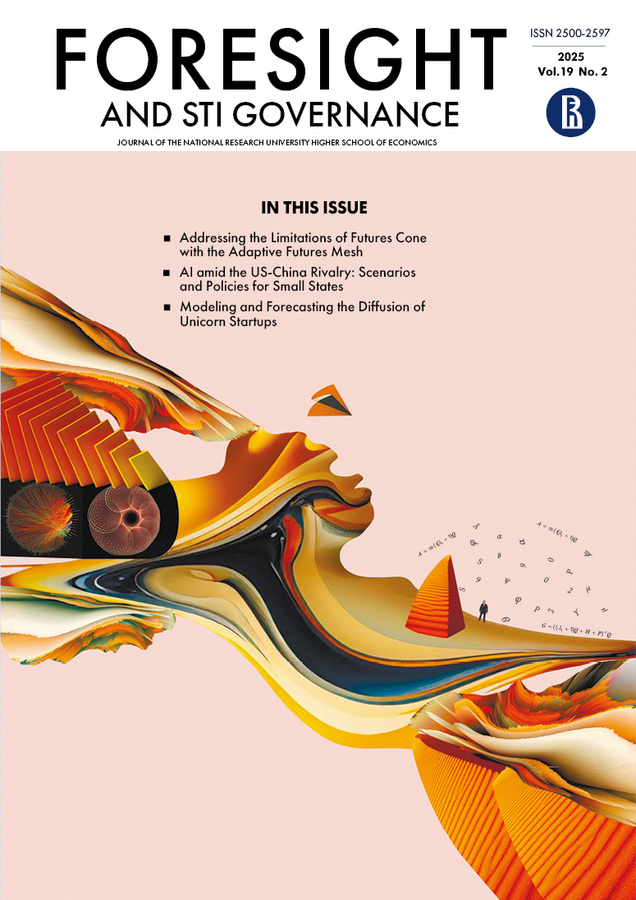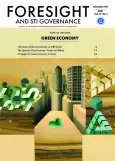The Impact of R&D Expenditure upon the Efficiency of M&A Deals with Hi-Tech Companies
- Authors: Ochirova E.1, Dranev Y.1
-
Affiliations:
- HSE University
- Issue: Vol 15, No 1 (2021)
- Pages: 31-38
- Section: INNOVATION
- URL: https://journals.rcsi.science/1995-459X/article/view/303342
- DOI: https://doi.org/10.17323/2500-2597.2021.1.31.38
- ID: 303342
Cite item
Abstract
The motives behind merger and acquisitions (M&A) are often linked with the opportunities to obtain knowledge and technologies in order to enhance the competitive advantages of companies. In particular, the acquisition of digital technologies through mergers and acquisitions with ICT companies is especially relevant. However, the efficiency of such deals is often low and calls into question the implementation of digitalization strategies of companies. In this study we employ an approach for assessing the efficiency of M&A deals with ICT companies by using the DEA method. Applying regression analysis, it was found that the high level of research and development expenses of acquirers can negatively impact the efficiency of the M&A deals with ICT companies.
About the authors
E. Ochirova
HSE University
Author for correspondence.
Email: eochirova@hse.ru
Y. Dranev
HSE University
Email: ydranev@hse.ru
References
- Ahuja G., Katila R. (2001) Technological acquisitions and the innovation performance of acquiring firms: A longitudinal study. Strategic Management Journal, 22, 197-220. DOI: https://doi.org/10.1002/smj.157
- Alam A., Uddin M., Yazdifar H. (2019) Institutional determinants of R&D investment: Evidence from emerging markets. Technological Forecasting and Social Change, 138, 34-44. DOI: https://doi.org/10.1016/j.techfore.2018.08.007
- Andrade G., Stafford E. (2004) Investigating the economic role of mergers. Journal of Corporate Finance, 10 (1), 1-36. DOI: https://doi.org/10.1016/S0929-1199(02)00023-8
- Audretsch D.B., Belitski M. (2020) The role of R&D and knowledge spillovers in innovation and productivity. European Economic Review, 123, 103391. DOI: https://doi.org/10.1016/j.euroecorev.2020.103391
- Belderbos R., Cassiman B., Faems D., Leten B., Van Looy B. (2014) Co-ownership of intellectual property: Exploring the value-appropriation and value-creation implications of co-patenting with different partners. Research Policy, 43(5), 841-852. DOI: https://doi.org/10.1016/j.respol.2013.08.013
- Benou G., Madura J. (2005) High-tech acquisitions, firm specific characteristics and the role of investment bank advisors. The Journal of High Technology Management Research, 16(1), 101-120. DOI: https://doi.org/10.1016/j.hitech.2005.06.006
- Bloningen B.A., Taylor C.T. (2000) R&D intensity and acquisitions in high technology industries: Evidence from the US electronic and electrical equipment industries. Journal of Industrial Economics, 68(1), 47-70. https://www.jstor.org/stable/117483.
- Bogetoft P., Wang D. (2005) Estimating the Potential Gains from Mergers. Journal of Productivity Analysis, 23, 145-171. DOI: https://doi.org/10.1007/s11123-005-1326-7
- Bravo-Ortega C., Marin A.G. (2011) R&D and Productivity: A Two Way Avenue? World Development, 39(7), 1090-1107. DOI: https://doi.org/10.1016/j.worlddev.2010.11.006
- Brown J.R., Fazzari S.M., Petersen B.C. (2009) Financing innovation and growth: Cash flow, external equity, and the 1990s R&D boom. The Journal of Finance, 64(1), 151-185. DOI: https://doi.org/10.1111/j.1540-6261.2008.01431.x
- Capron L., Hulland J. (1999) Redeployment of brands, sales forces, and general marketing management expertise following horizontal acquisitions: A resource-based view. Journal of Marketing, 63(2), 41-54. https://doi.org/10.1177%2F002224299906300203.
- Cassiman B., Colombo M.G., Garrone P., Veugelers R. (2005) The impact of M&A on the R&D process: An empirical analysis of the role of technological- and market-relatedness. Research Policy, 34(2), 195-220. DOI: https://doi.org/10.1016/j.respol.2005.01.002
- Chakrabarti A., Hauschildt J. Suverkrup C. (1994) Does it pay to acquire technological firms? R&D Management, 24, 047-056. DOI: https://doi.org/10.1111/j.1467-9310.1994.tb00846.x
- Chan L., Lakonishok J., Sougiannis T. (2001) The Stock Market Valuation of Research & Development Expenditures. Journal of Finance, 56(6), 2431-2456. DOI: https://doi.org/10.1111/0022-1082.00411
- Charnes A., Cooper W.W., Rhodes E. (1978) Measuring the efficiency of decision making units. European Journal of Operational Research, 2, 429-444. DOI: https://doi.org/10.1016/0377-2217(78)90138-8
- Cloodt M., Hagedoorn J., Kranenburg H.V. (2006) Mergers and acquisitions: Their effect on the innovative performance of companies in high-tech industries. Research Policy, 35(5), 642-654. DOI: https://doi.org/10.1016/j.respol.2006.02.007
- Cohen W., Levinthal D. (1990) Absorptive Capacity: A New Perspective on Learning and Innovation. Administrative Science Quarterly, 35(1), 128-152. DOI: https://doi.org/10.2307/2393553
- DeYoung R., Evanoff D.D., Molyneux P. (2009) Mergers and acquisitions of financial institutions: A review of the post-2000 literature. Journal of Financial Services Research, 36(2-3), 87-110. DOI: https://doi.org/10.1007/s10693-009-0066-7
- Desyllas P., Hughes A. (2008) Sourcing technological knowledge through corporate acquisition: Evidence from an international sample of high technology firms. The Journal of High Technology Management Research, 18(2), 157-172. DOI: https://doi.org/10.1016/j.hitech.2007.12.003
- Duysters G., Hagedoorn J. (2001) Do Company Strategies and Stuctures Converge in Global Markets? Evidence from the Computer Industry. Journal of International Business Studies, 32, 347-356. DOI: https://doi.org/10.1057/palgrave.jibs.8490956
- Eisfeldt A.L., Papanikolaou D. (2014) The value and ownership of intangible capital. American Economic Review, 104 (5), 189-194. DOI: https://doi.org/10.1257/aer.104.5.189
- Emrouznejad A., Yang G.L. (2018) A survey and analysis of the first 40 years of scholarly literature in DEA: 1978-2016. Socio-Economic Planning Sciences, 61, 4-8. DOI: https://doi.org/10.1016/j.seps.2017.01.008
- Griffith R., Harrison R., Van Reenen J. (2006) How Special Is the Special Relationship? Using the Impact of U.S. R&D on U.K. Firms Spillovers as a Test of Technology Sourcing. American Economic Review, 96, 1859-1875.
- Griliches Z. (1958) Research Costs and Social Returns: Hybrid Corn and Related Innovations. Journal of Political Economy, 66 (5), 419-431. https://www.jstor.org/stable/1826669.
- Griliches Z. (1979) Issues in assessing the contribution of research and development to productivity growth. The Bell Journal of Economics, 10(1): 92-116. DOI: https://doi.org/10.2307/3003321
- Hagedoorn J. Duysters G. (2002) External Sources of Innovative Capabilities: The Preferences for Strategic Alliances or Mergers and Acquisitions. Journal of Management Studies, 39, 167-188. DOI: https://doi.org/10.1111/1467-6486.00287
- Hagedoorn J., Cloodt M. (2003) Measuring innovative performance: Is there an advantage in using multiple indicators? Research Policy, 32(8), 1365-1379. DOI: https://doi.org/10.1016/S0048-7333(02)00137-3
- Haleblian J., Devers C.E., McNamara G., Carpenter M.A., Davison R.B. (2009) Taking stock of what we know about mergers and acquisitions: A review and research agenda. Journal of Management, 35(3), 469-502. https://doi.org/10.1177%2F0149206308330554.
- Hall B.H. (1996) The private and social returns to research and development (NBER Working Paper No. R2092), Cambridge, MA: National Bureau of Economic Research.
- Healy P.M., Palepu K.G., Ruback R.S. (1992) Does corporate performance improve after mergers? Journal of Financial Economics, 31(2), 135-175. DOI: https://doi.org/10.1016/0304-405X(92)90002-F
- Hitt M., Hoskisson R., Ireland R., Harrison J. (1991) Effects of Acquisitions on R&D Inputs and Outputs. The Academy of Management Journal, 34(3), 693-706. DOI: https://doi.org/10.2307/256412
- Hitt M., Hoskisson R., Johnson R., Moesel D. (1996) The Market for Corporate Control and Firm Innovation. The Academy of Management Journal, 39(5), 1084-1119. DOI: https://doi.org/10.5465/256993
- Holger E., Vitt J. (2000) The Influence of Corporate Acquisitions on the Behavior of Key Inventors. R&D Management, 30, 105-120. DOI: https://doi.org/10.1111/1467-9310.00162
- Hung S.C., Lee Y., Lin B.W. (2006) R&D intensity and commercialization orientation effects on financial performance. Journal of Business Research, 59(6), 679-685. DOI: https://doi.org/10.1016/j.jbusres.2006.01.002
- Iwasa T., Odagiri H. (2004) Overseas R&D, knowledge sourcing, and patenting: An empirical study of Japanese R&D investment in the US. Research Policy, 33(5): 807-828. DOI: https://doi.org/10.1016/j.respol.2004.01.002
- Jemison D., Haspeslagh P. (1991) Managing Acquisitions: Creating Value through Corporate Renewal, New York: Free Press.
- Jovanovic B., Rousseau P.L. (2008) Mergers as reallocation. The Review of Economics and Statistics, 90(4), 765-776. DOI: https://doi.org/10.1162/rest.90.4.765
- King D.R., Slotegraaf R.J., Kesner I. (2008) Performance implications of firm resource interactions in the acquisition of R&D-intensive firms. Organization Science, 19(2), 327-340. DOI: https://doi.org/10.1287/orsc.1070.0313
- Koellinger P. (2008) The relationship between technology, innovation, and firm performance - Empirical evidence from e-business in Europe. Research Policy, 37(8), 1317-1328. DOI: https://doi.org/10.1016/j.respol.2008.04.024
- Kohers N., Kohers T. (2000) The value creation potential of high-tech mergers. Financial Analysts Journal, 56(3), 40-51. DOI: https://doi.org/10.2469/faj.v56.n3.2359
- Lane P.J., Lubatkin M. (1998) Relative absorptive capacity and interorganizational learning. Strategic Management Journal, 19: 461-477. :5%3C461::AID-SMJ953%3E3.0.CO;2-L. DOI: https://doi.org/10.1002/(SICI)1097-0266(199805)19
- Liu H., Chen T., Pai L. (2007) The Influence of Merger and Acquisition Activities on Corporate Performance in the Taiwanese Telecommunications Industry. The Service Industries Journal, 27(8), 1041-1051. DOI: https://doi.org/10.1080/02642060701673729
- Lozano S., Villa G. (2010) DEA-based pre-merger planning tool. Journal of the Operational Research Society, 61(10), 1485-1497. DOI: https://doi.org/10.1057/jors.2009.106
- Mansfield E. (1988) Industrial R&D in Japan and the United States: A Comparative Study. The American Economic Review, 78(2): 223-228. https://www.jstor.org/stable/1818127.
- Ortega-Argiles R., Piva M., Potters L., Vivarelli M. (2010) Is corporate R&D investment in hightech sectors more effective? Contemporary Economic Policy, 28, 353-365. DOI: https://doi.org/10.1111/j.1465-7287.2009.00186.x
- Peters R.H., Taylor L.A. (2017) Intangible capital and the investment-q relation. Journal of Financial Economics, 123(2): 251-272. DOI: https://doi.org/10.1016/j.jfineco.2016.03.011
- Peyrache A. (2013) Industry structural inefficiency and potential gains from mergers and break-ups: A comprehensive approach. European Journal of Operational Research, 230(2): 422-430. DOI: https://doi.org/10.1016/j.ejor.2013.04.034
- Phillips G.M., Zhdanov A. (2013) R&D and the Incentives from Merger and Acquisition Activity. The Review of Financial Studies, 26(1): 34-78. DOI: https://doi.org/10.1093/rfs/hhs109
- Phillips R.L., Ormsby R. (2016) Industry classification schemes: An analysis and review. Journal of Business & Finance Librarianship, 21(1), 1-25. DOI: https://doi.org/10.1080/08963568.2015.1110229
- Prabhu J.C., Chandy R.K., Ellis M.E. (2005) The Impact of Acquisitions on Innovation: Poison Pill, Placebo, or Tonic? Journal of Marketing, 69(1), 114-130. https://journals.sagepub.com/doi/. DOI: https://doi.org/10.1509/jmkg.69.1.114.55514#
- Ranft A., Lord M. (2002) Acquiring New Technologies and Capabilities: A Grounded Model of Acquisition Implementation. Organization Science, 13(4), 420-441. https://www.jstor.org/stable/3085975.
- Ranft A.L., Lord M.D. (2000) Acquiring new knowledge: The role of retaining human capital in acquisitions of high-tech firms. The Journal of High Technology Management Research, 11(2): 295-319. DOI: https://doi.org/10.1016/S1047-8310(00)00034-1
- Ravenscraft D., Scherer F. (1987) Life After Takeover. The Journal of Industrial Economics, 36(2): 147-156. DOI: https://doi.org/10.2307/2098409
- Ravenscraft D., Scherer F.M. (1982) The lag structure of returns to research and development. Applied Economics, 14 (6), 603-620. DOI: https://doi.org/10.1080/00036848200000036
- Sirmon D.G., Hitt M.A., Ireland R.D., Gilbert B.A. (2011) Resource Orchestration to Create Competitive Advantage: Breadth, Depth, and Life Cycle Effects. Journal of Management, 37(5), 1390-1412. https://doi.org/10.1177%2F0149206310385695.
- Stoneman P., Kwon M.J. (1996) Technology adoption and firm profitability. The Economic Journal, 106(437), 952-962. DOI: https://doi.org/10.2307/2235366
- Wagner M. (2011) To explore or to exploit? An empirical investigation of acquisitions by large incumbents. Research Policy, 40(9): 1217-1225. DOI: https://doi.org/10.1016/j.respol.2011.07.006
- Wanke P., Maredza A., Gupta R. (2017) Merger and acquisitions in South African banking: A network DEA model. Research in International Business and Finance, 41, 362-376. DOI: https://doi.org/10.1016/j.ribaf.2017.04.055
- Worthington A.C. (2001) Efficiency in pre?merger and post?merger non?bank financial institutions. Managerial and Decision Economics, 22, 439-452. DOI: https://doi.org/10.1002/mde.1033
- Xie E., Reddy K.S., Liang J. (2017) Country-specific determinants of cross-border mergers and acquisitions: A comprehensive review and future research directions. Journal of World Business, 52(2), 127-183. DOI: https://doi.org/10.1016/j.jwb.2016.12.005
Supplementary files









